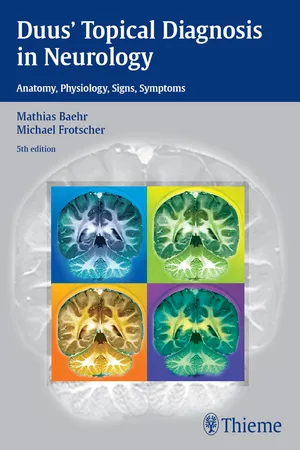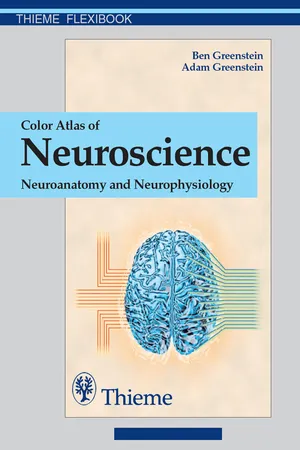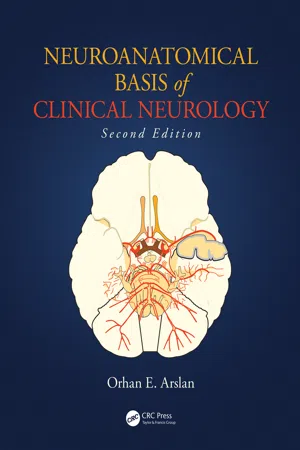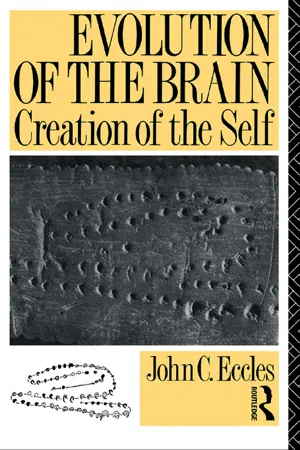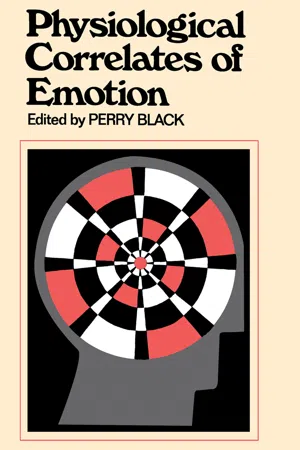Psychology
Limbic System
The limbic system is a complex network of brain structures involved in emotions, motivation, and memory. It includes the amygdala, hippocampus, and hypothalamus, among other regions. The limbic system plays a crucial role in regulating emotional responses, forming and retrieving memories, and influencing behaviors related to survival and reproduction.
Written by Perlego with AI-assistance
Related key terms
1 of 5
11 Key excerpts on "Limbic System"
- eBook - PDF
Topical Diagnosis in Neurology
Anatomy, Physiology, Signs, Symptoms
- Mathias Bähr, Michael Frotscher(Authors)
- 2019(Publication Date)
- Thieme(Publisher)
More recently, however, the concept of the lim-bic system as a discrete functional unit has come into question, as further studies have shown that the limbic structures possess important neural connections not just with each other but with outside structures as well. Thus, the Limbic System cannot be regarded as a closed system in either an anatomical or a functional sense. The functions associated with the Limbic System, such as instinc-tual and affective behavior, motivation, and drive, as well as learning and memory (see ▶ Functions of the Limbic System), should not be thought of as the preserve of the Limbic System alone. These functions depend on an intact cooperation of the Limbic System with many other areas of the brain. Once this has been understood, there is no fur-ther objection to the use of the term Limbic System , 7 Limbic System Fig . 7 .1 The limbic cortex . The Limbic System is composed of both neocor-tical and phylogenetically older cortical areas (portions of the archicortex and paleocortex) and a number of nuclei . The cellular architecture of the archicortex and paleocortex differs from that of the neocortex. The major structures of the lim-bic system are the hippocampal formation, the parahippocampal gyrus and entorhinal area, the dentate gyrus, the cingulate gyrus, the mamil-lary body, and the amygdala. These structures are interconnected in the Papez circuit and also make extensive connections with other regions of the brain (neocortex, thalamus, and brainstem). The Limbic System thereby enables communica-tion between mesencephalic, diencephalic, and neocortical structures. Through its connection with the hypothalamus, and thus with the autonomic nervous system, the Limbic System participates in the regulation of drive and affective behavior . Its main func-tion, teleologically speaking, is said to be the gen-eration of behavior that promotes the survival of the individual and of the species. - eBook - PDF
Duus' Topical Diagnosis in Neurology
Anatomy, Physiology, Signs, Symptoms
- Mathias Baehr, Michael Frotscher(Authors)
- 2012(Publication Date)
- Thieme(Publisher)
7 7 Limbic System Anatomical Overview . . . . . . . . . . . . . . 202 Major Components of the Limbic System . . . . . . . . . . . . . . . . . . . . . . . . . . 203 Functions of the Limbic System . . . . . 206 7 202 7 Limbic System The Limbic System is composed of both neocortical and phylogenetically older cortical areas (portions of the archicortex and paleocortex) and a number of nuclei . The cellular architecture of the archicor-tex and paleocortex differs from that of the neo-cortex. The major structures of the Limbic System are the hippocampal formation, the parahippo-campal gyrus and entorhinal area, the dentate gyrus, the cingulate gyrus, the mamillary body, and the amygdala. These structures are intercon-nected in the Papez circuit and also make extensive connections with other regions of the brain (neo-cortex, thalamus, brainstem). The Limbic System thereby enables communication between mesen-cephalic, diencephalic, and neocortical structures. Through its connection with the hypothalamus, and thus with the autonomic nervous system, the Limbic System participates in the regulation of drive and affective behavior. Its main function, tel-eologically speaking, is said to be the generation of behavior that promotes the survival of the in-dividual and of the species. Important functions are ascribed to the amygdala in behavior as-sociated with fear and anxiety. Moreover, the hip-pocampus plays a very important role in learning and memory. Lesions of the hippocampal forma-tion, or of other structures that are functionally as-sociated with it, produce an amnestic syndrome. Different disturbances of memory can arise, de-pending on the site of the lesion. Anatomical Overview Broca, in 1878, described the ring of brain convolu-tions surrounding the corpus callosum, dien-cephalon, and basal ganglia, naming it the “grand lobe limbique” (great limbic lobe, from the Latin limbus , ring). - eBook - PDF
Color Atlas of Neuroscience
Neuroanatomy and Neurophysiology
- Ben Greenstein, Adam Greenstein(Authors)
- 2011(Publication Date)
- Thieme(Publisher)
316 Limbic System 1: Introduction The term Limbic System is derived from the Latin word limbus , meaning a border, and was introduced by the neuroana-tomist Pierre Paul Broca to describe the ring of gyri that surround the brain stem. In 1937, James Papez described a circuit that he suggested formed the anatomical site for emotion . His circuit consisted of the hypothalamus , mamillary bodies , anterior thalamic nuclei , cingulate gyrus , and hippocampal formation . His basic proposal still stands, although the circuitry has been extended to include other structures. His circuit has been en-larged to include the septal area , the nu-cleus accumbens , and neocortical areas including the amygdala , and orbitofron-tal cortex . The limbic structures are phylo-genetically very ancient, and the hippo-campal formation includes a primitive form of cortex underlying the evolution-arily newer neocortex. The Limbic System includes the follow-ing areas of gray matter: the limbic lobe, the hippocampal formation, the amyg-daloid nucleus, and the anterior nucleus of the thalamus. The connecting pathways of the system are the alveus , fimbria , for-nix , mamillothalamic tract , and the stria terminalis . Papez originally suggested that emotion is appreciated by higher cognitive centers, and that there must therefore be reciprocal communication between the hypothalamus, an area that generates emotions such as rage, and the higher centers. According to his hypothe-sis, the hypothalamus feeds emotional in-formation to the cingulate gyrus through the mamillary bodies and the mamil-lothalamic tract, via the anterior thalamic nuclei. The cortex in turn modulates hy-pothalamic function through the hippo-campal formation, which processes infor-mation and communicates it to the hy-pothalamus via the fornix. This essentially correct hypothesis has been extended to include pathways from the association cortex to the cingulate gyrus and the en-torhinal cortex . - eBook - PDF
- Orhan E. Arslan(Author)
- 2014(Publication Date)
- CRC Press(Publisher)
387 17 Limbic System The Limbic System (visceral brain) directly or indirectly affects somatic and visceral motor (autonomic) functions by modulating the activities of the brainstem reticular formation, spinal cord, and the hypothalamus. It maintains homeostasis, integrates the olfactory impulses, changes the behavioral pat-tern, and modifies or inhibits reactions to stimuli via reward-ing and punishing centers. It also influences the activities of the pituitary gland. This system plays an important role in encoding and establishing memory patterns. Virtually all sensory systems including olfactory, visual, and audi-tory impulses maintain connections to the Limbic System. It encompasses the entorhinal cortex and associated connec-tions, hippocampal formation (cornu ammonis, subiculum, dentate gyrus), thalamus including the anterior and dorso-medial nuclei, hypothalamic areas and nuclei, septal area, induseum griseum, amygdala, prefrontal cortex, cingulate and parahippocampal gyri, epithalamus including the pineal gland, habenula, and stria medullaris thalami. Thus, the Limbic System regulates emotion, behavior, drive, long-term memory, maintenance of cognitive maps for naviga-tion, and learning processes. This system is also involved the formation of spatial memory, processing of the signals that convey motivationally significant stimuli related to reward and fear as well as social behavior. In summary, it is a system that integrates the activities that preserve the individual and species. The limbic lobe includes Brodmann areas 35a, 29, 24a, b, c, and Brodmann area 25, which are represented by the medial part of the perirhinal, retrosplenial, ventral parts of the anterior cingu-late, and infralimbic cortices, respectively. - eBook - ePub
- John C. Eccles(Author)
- 2005(Publication Date)
- Routledge(Publisher)
Chapter five Cerebral Limbic System in relation to the evolution of the reproductive and emotional systems
The Limbic System is the name given to a complex assemblage of neural centres and their communicating pathways. It is situated at the base of the cerebral cortex and can be partly seen on the medial side of a midline section of the cerebrum (Figures 4.4 and 5.1 ). It will be the thesis of this chapter that the Limbic System plays a key role in the evolutionary survival and eventual success of hominids. A detailed account of the anatomy is not required for our evolutionary story. Reference may be made to Brodal (1981) and Isaacson (1974) for a full account.Figure 5.1 Medial view of the hemisphere outlining the subdivisions of the presumed cortical limbic structures. Corpus callosum and anterior commissure (black); olfactory bulb to left leading by olfactory tract to piriform cortex; hippocampus (open circles) with output by curving fornix (see Figure 5.2a ). (Stephan, 1975.)5.1 Some anatomical considerations
In Figure 5.2a the assemblage of nuclei called the amygdala (A) is the centre of the action. It is so named because of its almond-like shape. It is embedded on the inner side of the temporal pole beneath area 34 in Figure 4.4 . As shown by the arrows, it projects directly to the hypothalamus and also indirectly via the stria terminals. The hypothalamus is shown by vertical hatching (H). We will not be concerned with its many constituent nuclei. Brodal's (1981) subdivision of the amygdala into a corticomedial and a basolateral group is valuable in that it accords with most studies on the effects of stimulation and ablation. Also shown is a path from the amygdala to the septal nuclei. Not shown in Figure 5.2a are the inputs to the amygdala from the olfactory bulb, either directly or via the piriform cortex (Figure 5.3 ), and from various thalamic nuclei and cortical zones (see Figure 5.3 ).In Figure 5.2b the septal nuclei (S) are in the centre of the action. Of special importance is the medial forebrain bundle (MFB) with its two-way communication to the tegmentum and the hypothalamus. Also there is another descending pathway via the stria medullaris to the habenula nucleus and thence to the tegmentum and the interpeduncular nucleus. Thus the septal nuclei have good communications to the brain stem with the potentiality of evoking general bodily responses. In Figure 5.2a - eBook - PDF
- Allan Siegel(Author)
- 2004(Publication Date)
- CRC Press(Publisher)
81 5 Limbic System I: Behavioral, Anatomical, and Physiological Considerations In this chapter, results are summarized of studies attempting to identify the relation-ships of a group of forebrain regions in aggression and rage referred to as “limbic” structures. The word “limbic” means “border” in Latin, and thus, the structures comprising the Limbic System are generally interposed between the overlying cere-bral cortex and underlying diencephalon. These structures include phylogenetically older regions of the telencephalon and include the hippocampal formation, septal area, and amygdala. In considering the Limbic System, it is also useful to include the prefrontal cortex and cingulate gyrus as components of this system because of their effects on visceral processes that parallel those of other limbic structures. One of the defining properties of limbic structures is that they project directly or indirectly to the hypothalamus or midbrain periaqueductal gray (PAG). In so doing, limbic structures modulate the functions typically associated with the hypo-thalamus or PAG. The anatomical bases by which each of these limbic structures can regulate visceral processes will be considered in detail in the next chapter. While the major focus of the analysis considers how these limbic structures affect aggres-sion and rage, it should also be noted that several of these structures also mediate other processes such as short-term memory and epileptogenic activity that are appar-ently unrelated to functions of the hypothalamus or PAG. As part of an overview of this system, it is useful to mention several features concerning the input–output relationships of limbic structures, which perhaps can help to provide understanding of how these structures may modulate aggression and rage. As a general rule, limbic structures receive inputs from at least two sources: (1) either directly or indirectly from one or more sensory systems; and (2) monoam-inergic fiber systems. - Randy W. Beck(Author)
- 2011(Publication Date)
- Churchill Livingstone(Publisher)
The Limbic System was traditionally thought of as the integration system for olfaction and hence the old term rhinencephalon. It is now clear that the limbic structures are involved in a variety of functions that define us as human. The Limbic System is involved in the complex integration of multimodal information concerning olfactory, visceral, and somatic input that emerges in the form of emotional and behavioural responses. This involves such behaviours as seeking and capturing prey, courtship, mating, raising children, the socialisation of aggression, and the maintenance of human relationships. The Limbic System also plays a role in the development of emotional drives and the establishment of memory.Anatomical components of the Limbic System
The exact components of the Limbic System remain open for debate. For our purposes in this text the following structures will be considered as components of the Limbic System (Figs 12.1 and 12.2 ):- • The olfactory nerves, bulb, and tract;
- • The anterior olfactory nucleus;
- • The olfactory striae and the olfactory gyri;
- • The olfactory trigone;
- • The anterior perforated substance;
- • The olfactory tubercle;
- • The piriform lobe;
- • The amygdaloid complex of nuclei;
- • Septum pellucidum and septum verum;
- • The hippocampal formation;
- • The fornix;
- • The stria terminalis;
- • The stria habenularis;
- • The cingulated and parahippocampal gyri;
- • The hypothalamus; and
- • The medial and anterior thalamus.
Figure 12.1 The Limbic System from a variety of views.Figure 12.2 Three-dimensional representation of the Limbic System.The olfactory bulb, tract, and cortex
The olfactory bulb and tract develop from ectodermal extensions of the anteromedial part of the primitive cerebral hemisphere. The bulb is radial in structure with six defined layers, which include, from the surface to the central core (Fig. 12.3- eBook - ePub
Why We Do What We Do
Understanding Our Brain to Get the Best Out of Ourselves and Others
- Dr Helena Boschi(Author)
- 2020(Publication Date)
- Wiley(Publisher)
We all know what it is like to experience emotions. Many of us feel a multitude of emotions in a single day. Some emotions help us, while other emotions can make a situation far worse.Emotions are subjective. Different events may evoke different emotions in us, depending on our background, personality and past experiences. For example, giving a presentation may be an enjoyable experience for some, but a source of intense anxiety for others.Emotions also help us communicate with other people and recognise how another person is feeling. When we are more aware of our own emotional state, we are often better able to read the emotional state of others.Equally, our emotions can often affect the way that other people feel; we do not always realise how contagious emotions are.Limbic System structure Function The hypothalamus Regulates homeostasis (our internal balance) and is one of the most active parts of the brain. The hypothalamus works with the pituitary gland to activate our endocrine system or hormonal release in every part of the body. Together these constitute our master gland and drive our responses. The amygdala (named after the Greek word for almond because of its shape) Activates in response to threats, although in recent years the amygdala has been linked to intense positive emotions as well.1 The amygdala labels an event emotionally relevant or important based on past experience. It receives information from the thalamus and communicates with the hypothalamus to stimulate our stress hormones, adrenaline and cortisol. When our amygdala is stimulated, it can turn a calm demeanour into aggressive or fearful behaviour. When the amygdala is damaged or destroyed, fear is not registered at all. The hippocampus (named after the Greek word for seahorse because of its shape) Converts experiences into personal or autobiographical (episodic - eBook - ePub
- Haiganoosh Whitaker, Harry A Whitaker, Haiganoosh Whitaker, Harry A Whitaker(Authors)
- 2013(Publication Date)
- Academic Press(Publisher)
4The Limbic System in Human Communication1
John T. Lamendella, SAN JOSE STATE UNIVERSITYPublisher Summary
The Limbic System plays an important role in human communication of all types. This chapter focuses on the role of Limbic System in social and communicative behavior. The Limbic System is responsible for the bulk of nonpropositional human communication. This forebrain network of cortical and subcortical structures has been thought of only in relation to its regulation of emotion and motivation, but in fact its range of functional responsibilities is large and includes major segments of social and communicative behavior. It is known that humans share these structures homologously with other mammals, and for nonhuman primates, the Limbic System comprises the level of neural activity that controls species-wide communication interactions. The chapter discusses the evolution of the Limbic System in human species, its development in human ontogeny, and several human clinical syndromes that have limbic etiologies. It also provides an overview of the relationship between limbic and linguistic communication. Moreover, limbic information processing is of interest not only as a nonverbal fringe to language but also because it lies at the heart of many theoretical issues currently under discussion in linguistics and psycholinguistics.INTRODUCTION
Recent investigations into the neurological substrata of language processing have tended to emphasize two areas of empirical research: first, the pathology and symptomology of language disorders , and second, the lateralization of language functions to one or the other cerebral hemisphere (cf. Dingwall & Whitaker, 1974 ). Common to both interests has been an almost exclusive concern for the neocortical systems of the brain and for language and speech. Reasonable as this may seem, such a focus actually provides too narrow a theoretical foundation because grammatically organized, phonologically structured verbal encodings of messages constitute only one of many levels and types of human communication. There has been both a general failure to distinguish adequately among the many varieties of communication systems characteristic of our species and an unhealthy reliance on the term language - eBook - PDF
- Wexler, David B.(Authors)
- 1010(Publication Date)
- New Harbinger Publications(Publisher)
Magnetic resonance imaging (MRI), positron emission tomog- raphy (PET), and computerized axial tomography (CAT) scans now give us a portrait of the human brain in different activities: working, play- ing, arguing, meditating, worrying, creating. Researchers have also identified individual neurons that fire as we observe the activities of others, helping us interpret their actions and feelings, and perhaps forming the neurophysiological basis for empathy. Fight or Flight The amygdala, a tiny almond-shaped structure in the primitive Limbic System, is at the center of the brain’s emotional life. The amygdala functions like a security alarm at your home. When it reads some event as violating the known rules of safe behavior, it goes nuts and sets off screeching sounds that put you in a zone where you can’t really think straight. When this alarm is activated in your body, you enter a primitive mind space in which words, thoughts, and consciousness are barely available. Hormones rule. It is here that your most potent emotional reactions are stirred. Situations that our brain perceives as emotional emergencies stimulate the signals to the amygdala. The amygdala scans the infor- mation for potential danger: Is this threatening to me? The amygdala is very dependent on associational patterns: if something about the current event is similar to an emotionally charged memory from the past, the Limbic System is likely to be activated in full force. So when your partner says or does something that telegraphs She doesn’t love me or She is disrespecting me or She might be leaving me, signals are activated along a pathway that serves as an express route to the amygdala. Once you determine that a situation represents a threat, a state of national emergency is declared. Civil rights and liberties are suspended, and you round up the usual suspects. The amygdala lights up the entire brain and body before the neocortex ever gets into the act. - eBook - PDF
- Perry Black(Author)
- 2012(Publication Date)
- Academic Press(Publisher)
In addi-tion they comment, as was done above, about the overlap and inter-connections of these reticulo-thalamo-cortical systems with those subserving visceral and autonomic functions, including the Limbic System. The Limbic System and its importance in emotion is dealt with in this volume by MacLean (Chapter 7) but mention of it here should be made because of its overlap and interconnections with the mid-brain, hypothalamic, and thalamic reticular systems and their interac-tions with the cortex, especially from an electrophysiological view-point. Green and Arduini (1954) studied the 5-to-7-per-sec theta wave activity in the hippocampus of rabbits and found that it bore a reciprocal relationship to the alpha rhythm of the cortex, i.e., when a stimulus caused desynchronization and blocking of the alpha rhythm it caused a synchronized theta rhythm in the hippocampus and, vice 150 Donald B. Lindsley versa, there tended to be desynchronization in the hippocampus when the alpha rhythm and synchrony was restored to the cortex. They proposed three hypotheses concerning the role of the hippo-campus in relation to the cortex: (1) the hippocampus facilitates or induces changes in the cortex, (2) the hippocampus exerts a re-straining or controlling influence on cortical activity, and (3) the hip-pocampus is affected by the same afferent modalities as the cerebral cortex, but subserves an entirely different function. They concluded that the arousal response in the hippocampus (rhythmic synchro-nized waves) has many features in common with EEG arousal in the cortex (desynchronization), and therefore also with behavioral arousal and alerting.
Index pages curate the most relevant extracts from our library of academic textbooks. They’ve been created using an in-house natural language model (NLM), each adding context and meaning to key research topics.

